#Ancient Daggers
Text

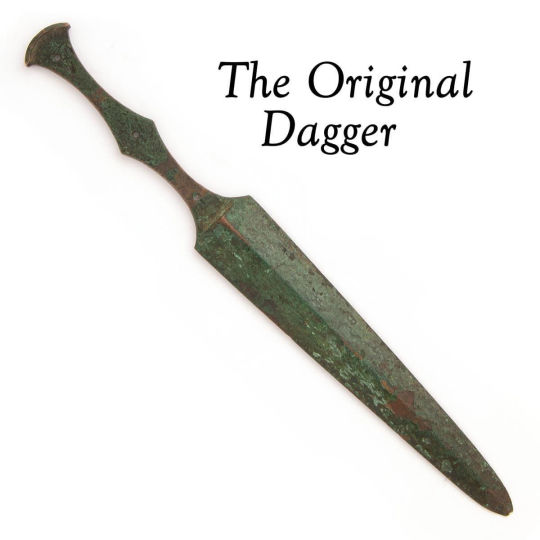


Windlass – Peloponnesian Bronze Greek Dagger
In 431 BC, Sparta, a city on the Greek peninsula of Peloponnese, declared war on Athens and its growing power. Sparta and the Peloponnesian League encircled Athens and destroyed its food supply. Athens brought its population inside the city walls, creating a disastrous situation that resulted in a plaque wiping out a third of its people and army, including General Pericles and his sons. Sparta became a leading power in Greece. This dagger is copied from an original in our possession (which is pictured above) that dates from the 9th -7th century BC-older than the Peloponnesian War but a design that was still in vogue at the time.
This Greek dagger is based on an original and its blade is bronze with a full tang like its historical example. The original likely had wood scales (which would have rotted). Windlass has instead used bone because of how attractive the material and color contrasts with bronze. The handle is very slim, but surprisingly durable due to its full tang construction and the grip is scalloped to aid grip during a thrust. The crescent-shaped pommel is an integral part of the tang and is flush with the scales. Windlass designed the sheath to be worthy of nobility (the original dagger doesn’t have one), with a highly embellished bronze throat and tip and three square medallions. The scabbard has a wood core and is covered with leather. A bronze ring is attached for lashing the sheath to a belt. A truly unique weapon suitable for any historical collection!
Please Note: We can sharpen the blade, but please be aware that the edge of the blade will be bright and lighter in color than the rest of the blade. Also, even though it is sharpened it is bronze and will not stay sharp for as long as a steel dagger would and may dull quickly.
#Kult of Athena#KultOfAthena#New Item Wednesday#Windlass Steelcrafts#Peloponnesian Bronze Greek Dagger#dagger#daggers#Knives & Daggers#weapon#weapons#blade#blades#Ancient Knives & Daggers#Ancient Daggers#Ancient Weapons#Greece#Greek Daggers#Greek Weapons#new item#new items#Peloponnese#Athens#Sparta#European Swords#European Weapons
56 notes
·
View notes
Photo

20 notes
·
View notes
Text

The Assassination of Julius Caesar by William Holmes Sullivan
#julius caesar#assassination#ides of march#art#william holmes sullivan#caesar#ancient rome#rome#roman#romans#theatre of pompey#assassins#conspiracy#conspirators#history#antiquity#roman republic#europe#european#dagger#daggers#toga#senators#dictator#et tu brute#shakespeare#william shakespeare
836 notes
·
View notes
Text










kiseki: dear to me as text posts (3/?)
#kiseki: dear to me#kiseki dear to me#ai di x chen yi#ai di#chen yi#kdtm#userspicy#useralias#mt#gifs#kdtmmemes#yes 65 year old coworker is zerui#yes he's like 30 I KNOW#rest of the main cast#is like 18-21 right#so he's basically ancient for them anyway#this is A JOKE#for the blond men one tho#i don't even have an explanation#i saw the post and it was funny#for me#ALSO couldn't use the actual dagger scene#for that dagger one#because it's like 1 second long#and fades to black#a crime against me personally
554 notes
·
View notes
Text

Bronze dagger with bone crescent pommel, Egypt, Middle Kingdom, 2033-1670 BC
from The Louvre
291 notes
·
View notes
Text

May your soul live, achieving millions of years, you who love Thebes, sitting with your face to the north wind, your eyes beholding happiness - inscription on the "wishing cup" lotus chalice, the first object encountered inside the antechamber of KV62
#happy belated 100th rediscovery anniversary king#aight so everything is based on objects from the tomb#thats The Duck Tunic#its number is 050a#it is adult sized#going on vogelsang-eastwoods colour reconstruction (its faded over 3300 yrs)#duckie sandals 021f and g based on veldmeijers reconstruction they are also adult sized#diadem and meteroric iron dagger and flexible inlaid apron were all found on his mummy#ring on his left hand is the kneeling king presenting maat one which was found on that finger of his mummy#holding the lotus chalice obvs#staff is based on the ones the guardian statues have#sash is based on 100f an Amarna style belt#openwork belt buckle (alleged) whose number i dont remember#bracelets were found on his mummy#no wig was found in the tomb so its based on his depiction on the golden throne#shebiu collar and broad collar also from the tomb and the shebiu is the correct colours i tried to make the collar correct too#anyway u get the idea#ancient egypt#my art#tutankhamun#archaeology#described in alt text#oh and the hieros say the good god nebkheperure the son of ra tutankhamun#given life forever
1K notes
·
View notes
Text

Roman pugio unearthed by archaeology intern in Germany, dates to the 1st century AD and underwent 9 months of restoration.
412 notes
·
View notes
Text

A 4,000-Year-Old Dagger Discovered in Poland
A copper dagger more than 4,000 years old was found in a forest near the town of Jarosław on the San River in south-eastern Poland. This discovery is the oldest dagger made of metal found in the Podkarpackie Voivodeship.
In the 3rd millennium BC, objects made of copper were extremely rare in the area, Dr Elżbieta Sieradzka-Burghardt, an archaeologist from the Jarosław museum, told PAP.
This valuable object, dating back over 4,000 years, was discovered last November by Piotr Gorlach of the Jarosław Historical and Exploration Association, who – with the permission of the Podkarpacie Regional Historical Monument Conservator in Przemyśl – conducted a search with a metal detector in the forests in the area of the Jarosław Forest Inspectorate, near the village of Korzenica.
“I had already finished my search for the day. When I returned to the car, I left the detector on out of habit. At some point, there was a signal. When I was digging up the forest floor, I saw a flat metal object covered with a green patina. I quickly realized that I was dealing with something much older than the military items from World War I and II that I was looking for in this area,” Gorlach said.
Archaeologists from the Museum in Jarosław Orsetti House identified the artifact as an extremely rare 4,000-year-old dagger. The ancient weapon was made of copper and measured just over 4 inches (10,5 cm) in length.
According to archaeologist Dr. Marcin Burghardt from the Jarosław Museum, the dagger discovered in Korzenica can be dated to the second half of the third millennium BC.
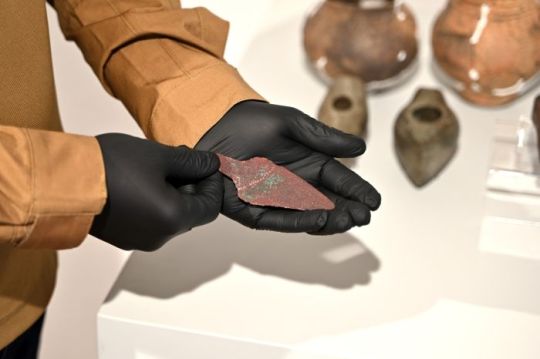
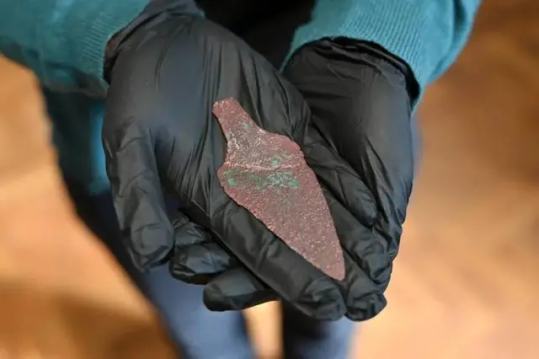
“In Polish lands, this is a period of enormous changes related to, among others, with a change in the main raw materials for the production of tools. Instead of flint tools commonly used in the Stone Age, more and more metal products appear, heralding the transition to the next period – the Bronze Age,” noted Dr. Burghardt.
In contrast, the now-discovered dagger from Korzenica – as noted by Dr Elżbieta Sieradzka-Burghardt, an archaeologist from the Jarosław museum – was not cast in bronze, but is made of copper.
“So it predates the development of bronze metallurgy,” the archaeologist noted. “In the third millennium BC, objects made of copper were extremely rare, so only people of the highest social status could afford them. There is rather no doubt that the dagger is not a local product,” Dr Burghardt-Sieradzka added.
During this period, metal products were imported from modern-day Ukraine or Hungary and only available to elites who could afford them. Links to the ancient weapon’s origin will be determined in the future through special metallurgical analysis.
By Leman Altuntaş.
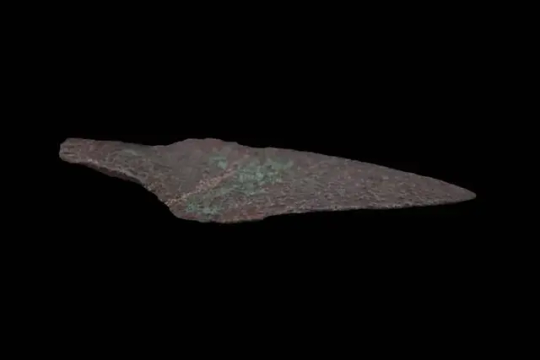
#A 4000-Year-Old Dagger Discovered in Poland#Jarosław#metal detecting#ancient artifacts#archeology#archeolgst#history#history news#ancient history#ancient culture#ancient civilizations
52 notes
·
View notes
Photo

TUTANKHAMUN’S IRON-BLADED DAGGER
[EGYPTIAN MUSEUM, CAIRO]
553 notes
·
View notes
Text


Bronze Age Daggers and Replica, Stonehenge Visitor Centre, nr. Salisbury, Wiltshire
#ice age#stone age#bronze age#copper age#iron age#neolithic#mesolithic#calcholithic#paleolithic#prehistory#prehistoric#dagger#weapon#ritual#replica#Stonehenge#ancient living#ancient cultures#ancient craft#metalwork#metalworking
82 notes
·
View notes
Text

Minoan bronze dagger with gold hilt, 18th-15th century BC
370 notes
·
View notes
Text



Windlass Peloponnesian Bronze Greek Dagger
In 431 BC, Sparta, a city on the Greek peninsula of Peloponnese, declared war on Athens and its growing power. Sparta and the Peloponnesian League encircled Athens and destroyed its food supply. #Athens brought its population inside the city walls, creating a disastrous situation that resulted in a plaque wiping out a third of its people and army, including General Pericles and his sons. Sparta became a leading power in Greece.
#Kult of Athena#KultOfAthena#Windlass Steelcrafts#Peloponnesian Bronze Greek Dagger#dagger#daggers#Knives & Daggers#weapon#weapons#blade#blades#Ancient Knives & Daggers#Ancient Daggers#Ancient Weapons#Greece#Greek Daggers#Greek Weapons#Peloponnese#Athens#Sparta#European Swords#European Weapons#Peloponnesian League
5 notes
·
View notes
Text
Si Vis Amari Ama
A Roman Guide to the Daggers

Author’s Note: As previously mentioned, for the sake of authenticity and historical accuracy, the characters in this AU series will be going by Latinized versions of their names. In some cases, that means literal Latin translations. In other cases, I chose popular Roman names that begin with the same letter as the characters’ call signs.
I put this little guide together as a reference so that it’s easy for people to identify each of the Dagger Squad members in this story. I also included a small glossary of Roman terms that will be used frequently throughout the story. I’ll continue to add to it as necessary!
Trust me when I say that I love chatting about this stuff, so if you ever have any questions, feel free to ask!
Gallus (Rooster) - The top gladiator in the private ludus of Atticus Cornelius Juventus. Fights in the Thracian style. Originally from Britannia.
Carnifex (Hangman) - A champion gladiator in the ludus of Atticus Cornelius Juventus. Fights in the Murmillo style. Originally from Gaul.
Felix (Fanboy) - A champion gladiator in the ludus of Atticus Cornelius Juventus. Fights in the Retiarius style. Sometimes paired to fight with Pollux. Originally from Hispania.
Pollux (Payback) - A champion gladiator in the ludus of Atticus Cornelius Juventus. Fights in the Murmillo style. Sometimes paired to fight with Felix. Originally from Africa.
Caius (Coyote) - A champion gladiator in the ludus of Atticus Cornelius Juventus. Fights in the Secutor style. Originally from Egypt.
Magnus (Maverick) - A former champion gladiator. Earned the title of Rudiarius after being granted his freedom. Magnus now trains the young gladiators in the ludus of Atticus Cornelius Juventus. Originally born into slavery in Rome.
Hrodebert (Bob) - A steward in the household of Atticus Cornelius Juventus. Handles money and accounts, particularly accounts related to the ludus. Originally from Germania.
Phoenix - A slave girl in the household of Atticus Cornelius Juventus. In addition to daily household chores, assists the ludus’ medicus, Titus in the care of wounded gladiators. Originally from Greece.
Key Roman Vernacular:
Ludus - A gladiator school
Lanista - The manager of a team of gladiators
Medicus - Doctor or physician
Dominus - Master (titled used by slaves for the male head of household)
Domina - Mistress/Lady (title used by slaves for the female head of household)
Pugiones - Daggers (the nickname used by Atticus Cornelius Juventus for his champion gladiators)
Rudiarius - A gladiator who has earned his freedom
#si vis amari ama ⚔️#Ancient Rome AU#bradley rooster bradshaw#rooster x reader#the dagger squad#a roman guide to the daggers
83 notes
·
View notes
Text

The Death of Caesar by Jean-Léon Gérôme
#julius caesar#assassination#ides of march#art#jean léon gérôme#caesar#theatre of pompey#ancient rome#rome#roman#romans#history#assassins#conspiracy#conspirators#senators#dagger#throne#roman republic#curia of pompey#senate#europe#european#brutus#cassius#marcus junius brutus#gaius cassius longinus#decimus junius brutus albinus#tillius cimber#servilius casca
309 notes
·
View notes
Text
Horse Handle Lapis Lazuli Dagger, Persia, 19th Century CE, The Al Sabah Collection, Kuwait
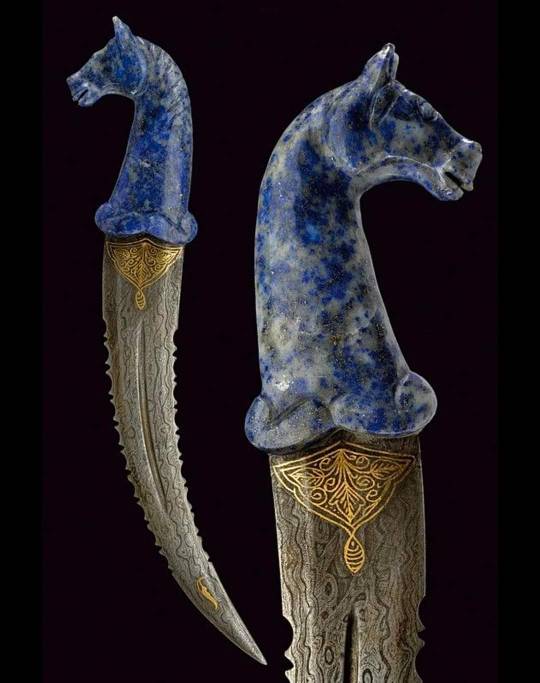
At Kolu Lapis Lazuli Hançer, İran, MS 19. Yüzyıl, Al Sabah Koleksiyonu, Kuveyt
#persia#prince of persia#iran#hançer#ancient knife#Lazuli Dagger#dagger#ancient art#collection#kuwait#kuveyt#ancient history
495 notes
·
View notes
Text

Bronze dagger, Egypt, circa 2055-1650 BC
from The National Museum of Scotland
342 notes
·
View notes